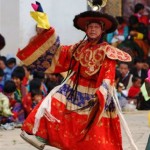In Bhutan the biggest and the most colourful festival is the “Tshechu”. The Tshechu is a festival honoring Guru Padma Sambhava (“one who was born from a lotus”) an Indian saint who contributed enormously to the diffusion of Tantric Buddhism in the Himalayan regions of Tibet, Nepal and Bhutan in the 8th century. He was the founder of the Nyingmapa sect, the “old school” of Mahayana Buddhism, which has a wide following today. The biography of the guru is highlighted by episodes based on the model of Buddha Sakyamuni’s life. Each episode is commemorated around the year on the 10th day of the month through a “Tshechu”. The dates and the duration of the festivals vary from one district to another, but they always take place on or around the 10th day of the month in the Bhutanese calendar.
The dances are performed by monks as well as lay people. Many of the dances were established by Zhabdrung Ngawang Namgyal or by Pema Lingpa. The dancers take on the aspects of wrathful and compassionate deities, heroes, demons and animals. The dances, known as cham, bring blessings upon the onlookers, instruct them in the dharma (Buddhist teachings), protect them from misfortune, and exorcise evil influences. The Tshechu is a religious festival and people believe they gain merit by attending it. Deities are invoked during the dances; through their power and benediction misfortunes may be annihilated, luck increased and wishes realized. The Tshechu is also a yearly social gathering where the people rejoice together, dressed in their finest clothing and jewellery.










